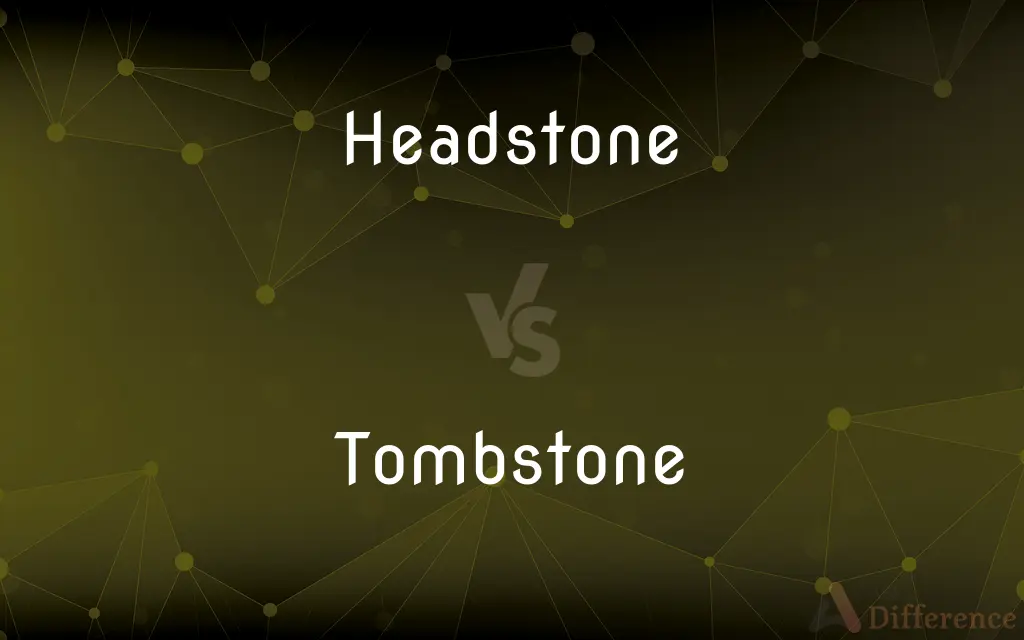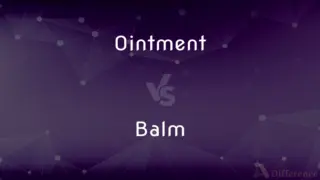Headstone vs. Tombstone — What's the Difference?
Edited by Tayyaba Rehman — By Fiza Rafique — Updated on April 1, 2024
Headstones mark the head of a grave and often feature inscriptions, focusing on memorialization, while tombstones historically marked tombs but are now commonly used interchangeably with headstones.

Difference Between Headstone and Tombstone
Table of Contents
ADVERTISEMENT
Key Differences
Headstones are markers placed at the head of a grave, primarily used to memorialize the deceased with inscriptions of their name, dates of birth and gone, and sometimes quotes or messages. They play a significant role in cemeteries as a way for loved ones to commemorate and remember the deceased. On the other hand, tombstones originally referred to the stone that covered or marked a tomb. Over time, the term "tombstone" has become synonymous with headstones, especially in common language, though it historically denotes a stone marking a tomb.
The primary purpose of a headstone is to serve as a lasting tribute to the person buried at the site, often reflecting something about the person’s life, beliefs, or personality. Whereas the original concept of a tombstone was more about marking the physical presence of a tomb, the modern usage tends to focus less on this distinction and more on the act of memorialization.
Material choices for headstones include granite, marble, and bronze, reflecting durability and the desire for a lasting monument. Tombstones, in the traditional sense, might have been simpler and made from local stone, but today, the materials used for what are now called tombstones and headstones are largely the same, focusing on longevity and aesthetic qualities.
Headstones can come in various shapes and sizes, ranging from flat markers to upright monuments, with customization options that allow families to personalize the memorial. Tombstones, particularly in their original use, might have been simpler or, in some cultures, more elaborate, depending on the practices of the time. Today, the variety in designs reflects personal choices and cultural practices in memorialization.
Despite these differences, in contemporary usage, the terms headstone and tombstone are often used interchangeably. This shift reflects a broader trend towards personalization in memorial practices, where the specific terms matter less than the personal meaning and intention behind the memorial.
ADVERTISEMENT
Comparison Chart
Definition
Marker at the head of a grave with inscriptions.
Historically, a stone marking a tomb; now often synonymous with headstone.
Purpose
Memorialization of the deceased with detailed inscriptions.
Originally to mark the physical presence of a tomb.
Material Choices
Granite, marble, bronze, chosen for durability.
Traditionally, might have varied more; now similar to headstone materials.
Design Variability
Wide range, from flat markers to elaborate monuments.
Originally simpler or culturally specific; now, designs are similar to headstones.
Contemporary Usage
Specifically denotes the marker at a grave's head.
Used interchangeably with headstone, focusing on memorialization.
Compare with Definitions
Headstone
Can be personalized.
They added a sculpture of a book to his headstone because he loved to read.
Tombstone
Materials chosen for longevity.
The bronze tombstone has weathered many years.
Headstone
Often made of durable materials.
The granite headstone remains pristine through the seasons.
Tombstone
Historically marked the entrance to a tomb.
The ancient tombstone was carved from local stone.
Headstone
A memorial stone at a grave’s head.
The headstone was beautifully engraved with her favorite quote.
Tombstone
Now often synonymous with headstones.
They chose a marble tombstone for her grave.
Headstone
Marks the specific location of a burial.
The headstone stands at the head of his final resting place.
Tombstone
Can feature inscriptions and personal details.
The tombstone bears her name and the dates of her life.
Headstone
A headstone, tombstone, or gravestone is a stele or marker, usually stone, that is placed over a grave. It is traditional for burials in the Christian, Jewish, and Muslim religions, among others.
Tombstone
Reflects personal or cultural practices in memorialization.
The tombstone's design includes symbols important to her heritage.
Headstone
A memorial stone set at the head of a grave.
Tombstone
A gravestone.
Headstone
Also head stone(Architecture) See keystone.
Tombstone
A headstone marking a person's grave.
Headstone
A gravestone, a grave marker: a monument traditionally made of stone placed at the head of a grave.
Tombstone
(mathematics) The symbol "∎" marking the end of a proof.
Headstone
The cornerstone or principal stone of a building.
Tombstone
A marker that takes the place of deleted data, allowing for replication of the deletion across servers etc.
Headstone
The principal stone in a foundation; the chief or corner stone.
Tombstone
(computing) A crashdump.
Headstone
The stone at the head of a grave.
Tombstone
(cardiology) An unusual morphological feature on an electrocardiogram indicative of acute myocardial infarction, characterized by a massive ST elevation.
Headstone
The central building block at the top of an arch or vault
Tombstone
(journalism) A printed advertisement in a newspaper or magazine, typically having unadorned centered text in black and white, enclosed in a simple box.
Headstone
A stone that is used to mark a grave
Tombstone
To take part in tombstoning: to jump into the sea, etc. from a cliff or other high point so as to enter the water vertically straight.
Tombstone
(surfing) For a surfboard to stand upright half-submerged in the water (like a tombstone, above) because the surfer is underwater with his or her legrope pulled tight. Often this indicates a surfer in difficulty, either held down by the power of a wave or unconscious and unable to get to the surface.
Tombstone
To replace (an object or data) with a tombstone marker.
Tombstone
A stone erected over a grave, to preserve the memory of the deceased.
Tombstone
A stone that is used to mark a grave
Common Curiosities
How do headstones and tombstones differ?
Originally, headstones marked graves while tombstones covered tombs. Today, the terms are often used synonymously, though headstones specifically refer to grave markers.
What is a tombstone?
Historically, a tombstone marked the entrance or cover of a tomb. In modern usage, it is commonly used interchangeably with headstone to refer to a grave marker.
Can tombstones and headstones be personalized?
Yes, both can be personalized with inscriptions, designs, and materials reflecting the deceased’s life, beliefs, or personality.
Why are durable materials preferred for headstones and tombstones?
Durable materials like granite, marble, and bronze are preferred to ensure the memorial withstands the elements and endures as a lasting tribute to the deceased.
How do cultural practices influence the design of headstones and tombstones?
Cultural practices can influence the design significantly, with certain symbols, materials, and shapes reflecting the deceased's heritage, beliefs, and family traditions.
What is the significance of inscriptions on headstones and tombstones?
Inscriptions serve to memorialize the individual, offering a brief glimpse into their life, values, or the love of those who remember them.
What is the process for creating a headstone or tombstone?
The process involves selecting the material, design, and inscriptions, often in consultation with a memorial provider or artisan.
Is there a difference in the purpose of headstones and tombstones today?
While historically different, today both serve the purpose of memorializing the deceased, with the distinction between the terms becoming less significant.
Can anyone choose the design for a headstone or tombstone?
Yes, families or individuals can choose the design, often working with memorial designers to create a fitting tribute.
What role do headstones and tombstones play in cemeteries?
They mark the specific locations of graves and serve as focal points for remembrance and mourning, as well as historical records.
Are the design options for headstones and tombstones the same?
Yes, in contemporary practice, the design options for what are now generally called tombstones and headstones are similar, offering a range of personalization choices.
How does one choose between a headstone and a tombstone?
Today, the choice is more about personal preference and the specific terms used by monument providers, as the functional differences have largely disappeared.
Share Your Discovery

Previous Comparison
Tatt vs. Tat
Next Comparison
Ointment vs. BalmAuthor Spotlight
Written by
Fiza RafiqueFiza Rafique is a skilled content writer at AskDifference.com, where she meticulously refines and enhances written pieces. Drawing from her vast editorial expertise, Fiza ensures clarity, accuracy, and precision in every article. Passionate about language, she continually seeks to elevate the quality of content for readers worldwide.
Edited by
Tayyaba RehmanTayyaba Rehman is a distinguished writer, currently serving as a primary contributor to askdifference.com. As a researcher in semantics and etymology, Tayyaba's passion for the complexity of languages and their distinctions has found a perfect home on the platform. Tayyaba delves into the intricacies of language, distinguishing between commonly confused words and phrases, thereby providing clarity for readers worldwide.
















































